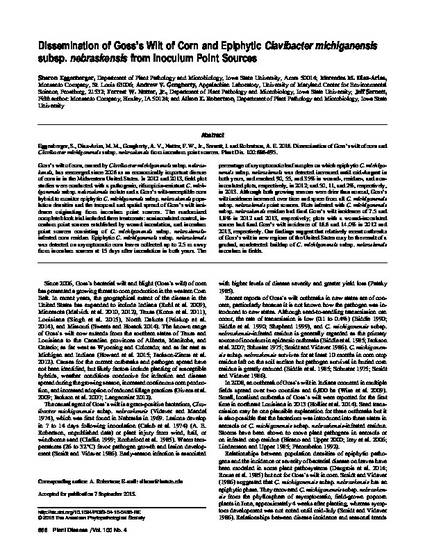
Goss’s wilt of corn, caused by Clavibacter michiganensis subsp. nebraskensis, has reemerged since 2006 as an economically important disease of corn in in the Midwestern United States. In 2012 and 2013, field plot studies were conducted with a pathogenic, rifampicin-resistant C. michiganensis subsp. nebraskensis isolate and a Goss’s wilt-susceptible corn hybrid to monitor epiphytic C. michiganensis subsp. nebraskensis population densities and the temporal and spatial spread of Goss’s wilt incidence originating from inoculum point sources. The randomized complete block trial included three treatments: noninoculated control, inoculum point sources established by wound inoculation, and inoculum point sources consisting of C. michiganensis subsp. nebraskensis-infested corn residue. Epiphytic C. michiganensissubsp. nebraskensis was detected on asymptomatic corn leaves collected up to 2.5 m away from inoculum sources at 15 days after inoculation in both years. The percentage of asymptomatic leaf samples on which epiphytic C. michiganensis subsp. nebraskensis was detected increased until mid-August in both years, and reached 90, 55, and 35% in wound-, residue-, and noninoculated plots, respectively, in 2012; and 50, 11, and 2%, respectively, in 2013. Although both growing seasons were drier than normal, Goss’s wilt incidence increased over time and space from all C. michiganensissubsp. nebraskensis point sources. Plots infested with C. michiganensis subsp. nebraskensis residue had final Goss’s wilt incidence of 7.5 and 1.8% in 2012 and 2013, respectively; plots with a wound-inoculated source had final Goss’s wilt incidence of 16.6 and 14.0% in 2012 and 2013, respectively. Our findings suggest that relatively recent outbreaks of Goss’s wilt in new regions of the United States may be the result of a gradual, nondetected buildup of C. michiganensis subsp. nebraskensisinoculum in fields.
Available at: http://works.bepress.com/alison-robertson/245/

This article is published as Eggenberger, S., Diaz-Arias, M. M., Gougherty, A. V., Nutter, F. W., Jr., Sernett, J. and Robertson, A. E. 2016. Dissemination of Goss’s wilt of corn and Clavibacter michiganensis subsp. nebraskensis from inoculum point sources. Plant Dis. 100:686-695. doi: 10.1094/PDIS-04-15-0486-RE. Posted with permission.